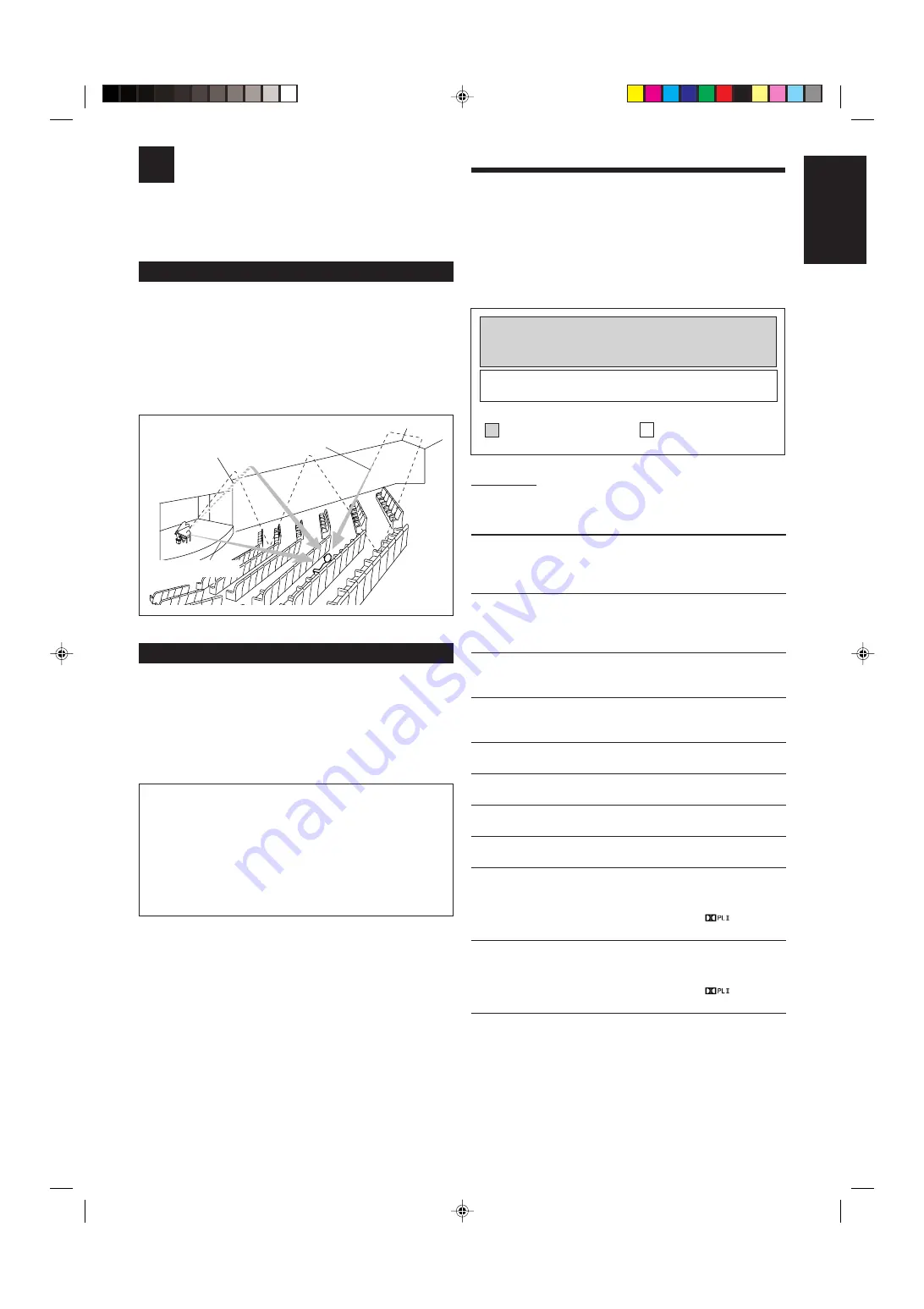
58
English
Using the DSP Modes
This unit provides a variety of DSP (Digital Signal Processor) modes. The stored basic settings and adjustments
performed on the Setup and Adjustment Menus (see pages 35 to 50) are applied.
•
The following operations are only possible when the receiver is ready for Zone 1 operations, and are used only
for the Zone 1 sources.
Early reflections
Reflections from
behind
Direct sounds
Reproducing the Sound Field
The sound heard in a concert hall, club, etc. consists of direct sound
and indirect sound—early reflections and reflections from behind.
Direct sounds reach the listener directly without any reflection. On
the other hand, indirect sounds are delayed by the distances of the
ceiling and walls. These direct sounds and indirect sounds are the
most important elements of the acoustic surround effects.
The DSP modes can create these important elements, and give you a
real “being there” feeling.
Introducing the DSP Modes
The DSP modes include the following modes—
• DAP (Digital Acoustic Processor) modes (LARGE HALL 1,
LARGE HALL 2, RECITAL HALL, OPERA HOUSE,
CHURCH, LIVE CLUB, DANCE CLUB, PAVILION, LARGE
THEATER, SMALL THEATER)
• ALL CH STEREO
• STEREO FILM/MONO FILM
HEADPHONE Mode
You can also enjoy the DSP effect (except All Channel Stereo
mode) through the headphones.
If you press DSP when the front speakers 1 and 2 are both
deactivated, HEADPHONE mode is activated without respect to
the type of software played back.
The DSP and HEADPHONE indicators also light up.
DAP modes
You can use the following DAP modes in order to reproduce a more
acoustic sound field in your listening room.
LARGE HALL 1
:
Reproduces the spatial feeling of a large
shoebox-shaped hall designed primarily for
classical concerts. (Its seating capacity is
about 2000.)
LARGE HALL 2
:
Reproduces the spatial feeling of a large
vineyard-shaped hall designed primarily for
classical concerts. (Its seating capacity is
about 2000.)
RECITAL HALL :
Reproduces the spatial feeling of a small hall
designed primarily for classical recitals.
(Seating capacity is about 500.)
OPERA HOUSE
:
Reproduces the spatial feeling of an opera
house with a high ceiling and multi-level
seating layout.
CHURCH
:
Reproduces the spatial feeling of a majestic
church with a high ceiling.
LIVE CLUB
:
Reproduces the spatial feeling of a live music
club with a low ceiling.
DANCE CLUB
:
Reproduces the spatial feeling of a rocking
dance club.
PAVILION
:
Reproduces the spatial feeling of an
exhibition hall with a high ceiling.
LARGE THEATER :
Reproduces the spatial feeling of a large theater
where the seating capacity is about 600. The
built-in Dolby Pro Logic II decoder is activated
for 2-channel software. (The
indicator
lights up.)
SMALL THEATER :
Reproduces the spatial feeling of a small theater
where the seating capacity is about 300. The
built-in Dolby Pro Logic II decoder is activated
for 2-channel software. (The
indicator
lights up.)
When using the DAP mode, the sounds come out of all the
connected and activated speakers.
•
If the surround speakers are deactivated,
JVC’s original
3D-PHONIC processing (which has been developed to create the
surround effect through the front speakers only) is used.
The 3D-PHONIC indicator lights up on the display.
Continued on the next page
To use the DSP modes,
press DSP so that the DSP modes change as
follows.
The DSP indicator also lights up on the display.
=
LARGE HALL 1
=
LARGE HALL 2
=
RECITAL HALL
=
OPERA HOUSE
=
CHURCH
=
LIVE CLUB
=
DANCE CLUB
=
PAVILION
=
ALL CH STEREO
=
LARGE THEATER
=
SMALL THEATER
=
STEREO FILM
=
MONO FILM
=
=
(Back to the beginning)
: Suitable for audio
sources
: Suitable for video
sources
EN51-60_RX-DP20VBK[C]f
03.6.12, 2:21 PM
58
















































